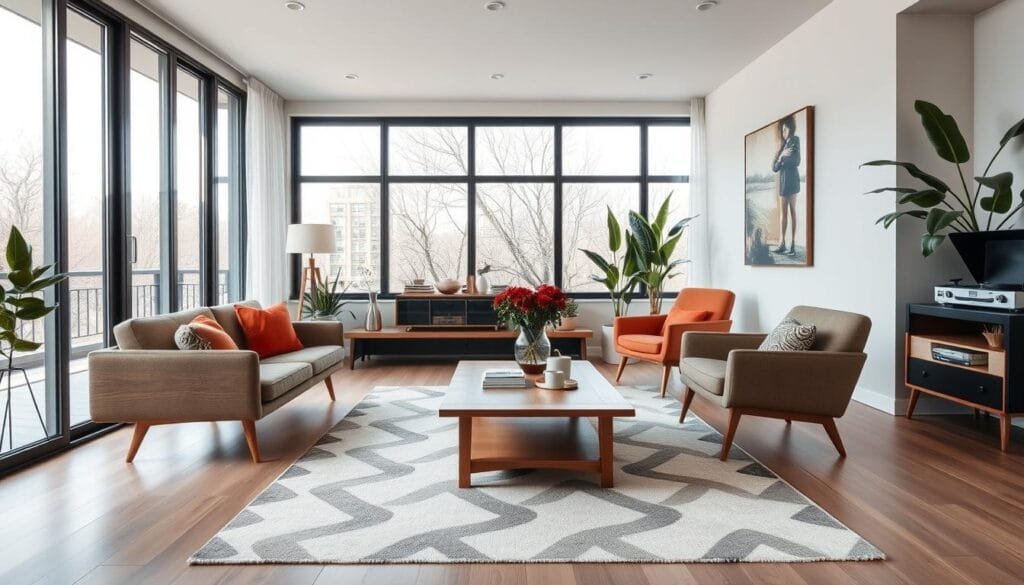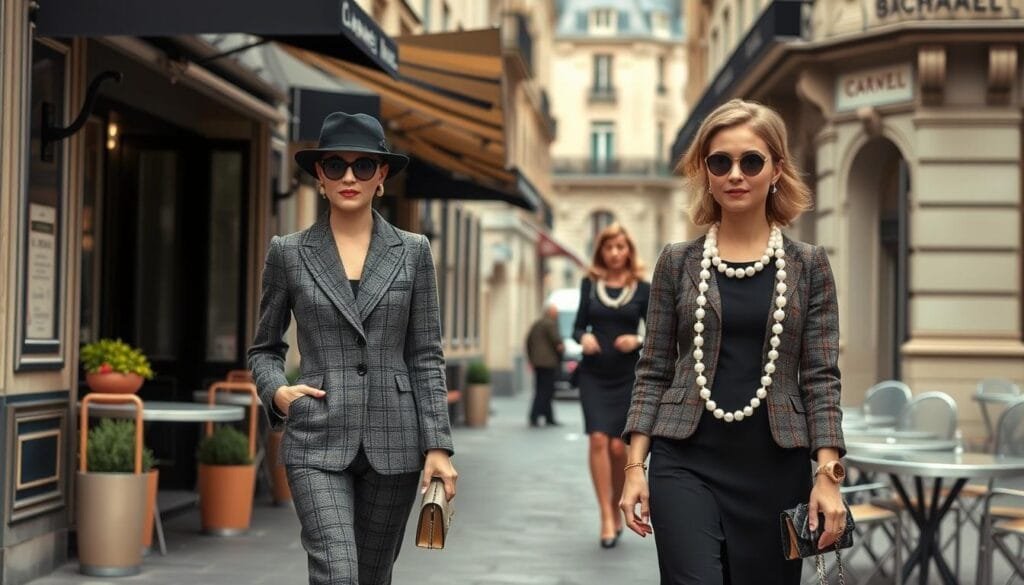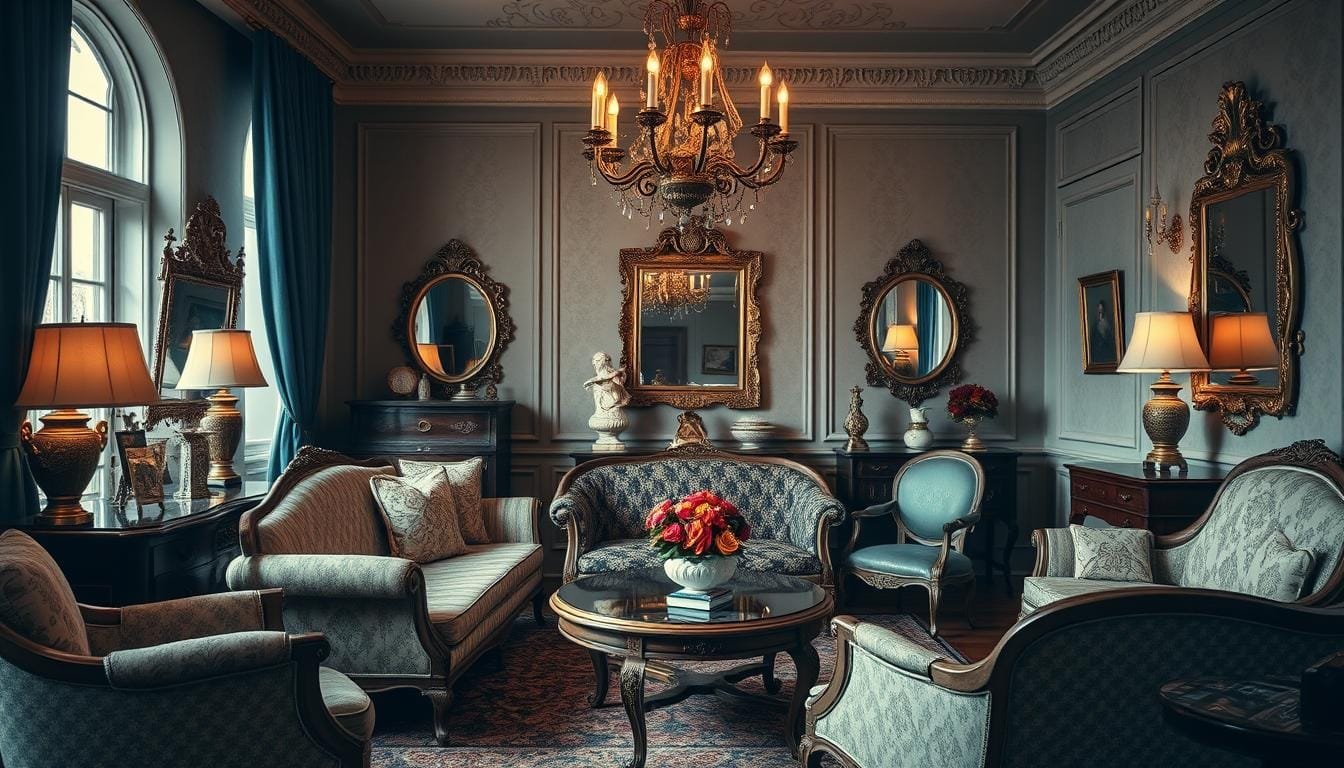Did you know trends in fashion and interior design last about 10 years? This shows how simple trends last longer, showing timeless elegance and style. Explore classic designs that never fade, like herringbone patterns from the Roman Empire or gilded framed paintings.
Colors like light blues and earthy greens bring calm to any space. Subway tiles are always in style for kitchens. These designs show quality and craftsmanship. They make your home beautiful and help the planet by avoiding constant updates.
Understanding the Concept of Classic Design
Classic design is all about harmony, balance, and lasting appeal. It answers the question, What Defines a Classic Design? These designs stay popular for decades, avoiding short-lived trends. They offer stability and familiarity in a fast-changing world, lasting emotionally and aesthetically.
The Volkswagen (VW) Beetle, designed by Ferdinand Porsche in the 1930s, was for everyday people with a small budget. The Mini motor car, created by Alec Issigonis in the late 1950s, was also made to be affordable and useful. Both show the lasting appeal of designs that are both functional and timeless.
The British Post has honored 50 iconic designs as “British Classic and Iconic Designs.” These designs have a lasting cultural impact. They remain popular long after they stop being made. Mass production helps make these designs common and accessible.
Classic designs often involve many experts, like ergonomists and electrical engineers. The Anglepoise lamp, designed by George Carwardine in 1934, focuses on being practical rather than just looking good. This shows how classic designs balance function and beauty.
A key trait of classic design is evoking strong emotions. The Juicy Salif lemon squeezer, designed by Philippe Starck in 1990, was meant to spark conversations. This shows classic design is more than just useful; it also stirs feelings of nostalgia or innovation, making it timeless.
| Designs | Designer | Year | Purpose |
|---|---|---|---|
| VW Beetle | Ferdinand Porsche | 1930s | Aimed at ordinary people |
| Mini Motor Car | Alec Issigonis | 1950s | Economical and functional |
| Anglepoise Lamp | George Carwardine | 1947 | Practical Function |
| Juicy Salif | Philippe Starck | 1990 | Conversation Starter |
What makes a design classic is its ability to stay iconic and relevant over time. Classic designs influence culture and keep their charm through generations, whether through practicality, emotional connection, or mass production.
For more insights into classic design’s lasting impact, visit the detailed exposition on their influential characteristics here.
Classic Fashion Trends That Endure
Some fashion items, like the little black dress and the trench coat, have stood the test of time. They continue to shape today’s style. These Iconic Pieces in Women’s Fashion are must-haves in any closet. In 2023, we’re seeing a focus on classic items like plain shirts and straight-leg jeans.
| Classic Piece | Description | Brands |
|---|---|---|
| Shirtdresses | Universally flattering and easy to style, available in various lengths and styles. | Everlane, Banana Republic, Tory Burch |
| Tailored Shirts | Expertly tailored for multiple occasions, providing a sleek and polished look. | The Frankie Shop, Raey |
| Handbags | Sleek and understated designs that complement any outfit. | The Row, Khaite, Aesther Ekme |
| Straight-Leg Jeans | Timeless denim style, versatile for various looks. | Zara, Agolde, Madewell, Frame |
| Blazers | Transitioned from strict office wear to versatile outerwear. | Altuzarra, Wardrobe NYC |
| Flat Shoes | Chic, comfortable options perfect for everyday wear. | The Row, Repetto, Maison Margiela |
| Cardigans | Fashionable layering pieces for seasonal transitions. | Miu Miu, Zara, Vince |
| Longline Overcoats | Stylish and functional, elevating any outfit into a classic look. | Mango, Proenza Schouler, Toteme, Burberry |
When we talk about Iconic Pieces in Women’s Fashion, we must remember the influence of style icons. Grace Kelly, Katherine Hepburn, Audrey Hepburn, and Elizabeth Taylor are key figures. They chose high-quality fabrics like linen, cashmere, tweed, and silk. Modern icons like Princess Diana and Carolyn Bessette-Kennedy also inspire us with their timeless elegance.
Investing in quality staple pieces is key to a classic wardrobe. Essentials like linen shirts, blazers, and denim jeans are always a good choice. Simple outfits like a white tee with high-rise jeans or a chic shift dress are timeless. Add your own touch with statement jewelry, bags, and shoes. These Iconic Pieces in Women’s Fashion show the enduring appeal of versatile wardrobe essentials.
Classic Furniture Styles for Your Home
Mid-Century Modern Designs are known for their clean lines and function. They fit well with many home themes. Traditional furniture has a long history, starting in the 17th century in Europe. It includes styles from the Jacobean era to Victorian and art nouveau.

The Chesterfield sofa and Chippendale chair are loved for their detailed work and history. Styles like Queen Anne and Louis XVI are popular in traditional furniture. Furniture from the 17th to 19th centuries was made from dark woods like walnut and oak, showing luxury.
Traditional furniture often has rich colors like deep burgundy and golden yellow. Velvet and silk were used to show wealth. Gold and silver accents were common, adding to the luxury.
Traditional furniture is known for its curved shapes and soft lines. Today, it blends old and new styles. In 2024, classic furniture is still a favorite among many.
In 2024, classic furniture colors include neutrals like beige and rich tones like red. Patterns like damask add to the beauty of classic pieces.
Mixing old and new styles is a trend. Decorative mirrors and vintage rugs enhance classic furniture. They add to the space’s elegance and charm.
The Role of Color in Classic Designs
Color plays a big role in how we see spaces. It’s key in Timeless Color Palettes that show classic design. Classic designs often use soft colors like whites, creams, beiges, and greys. These colors make a space look sophisticated and elegant.
Using different shades of neutrals adds depth and keeps the space lively. Warm neutrals like creamy whites and beige make a space cozy. Cool neutrals like greys and whites give a modern look. Colors like blues and greens are also popular for their lasting charm.
“Navy blue stands out as a timeless choice, striking a balance between formality and relaxation. Shades like Benjamin Moore’s Hale Navy and Sherwin-Williams’ Naval are top picks for creating depth and elegance.”
Classic designs also focus on quality materials and fabrics. Think oak, mahogany, cherrywood, ceramic, marble, and fancy finishes like gold and silver. These add texture and pattern, making the space interesting. Fabrics like silk and velvet add luxury and make the space feel special.
The 60-30-10 rule is key in timeless color schemes. It means 60% of the space is a main color, 30% is a secondary color, and 10% is an accent color. This mix creates a balanced and flexible design that works for any time.
Classic Architectural Styles Across Eras
Classic architectural styles tell us about our shared past. From Gothic Revival’s medieval elegance to Colonial’s symmetrical charm, each era has its own unique form. These styles shape our skylines, leaving behind markers of time and culture.
The Gothic Revival and Its Lasting Impact is seen in Europe’s majestic cathedrals. This style, with its pointed arches and ribbed vaulting, thrived in the 19th century. It still captures our imagination today with its dramatic flair.
Colonial architecture tells a different story across the Atlantic. It emerged in the 17th and 18th centuries, focusing on symmetry, harmony, and practicality. Its charm is seen in many homes and public buildings, showing simplicity and elegance.
Understanding the evolution of classical architectural elements gives us deeper insights. Sebastiano Serlio’s work on the five Classical orders helped shape many styles, including Georgian and Neoclassical.
| Period | Style | Key Features |
|---|---|---|
| Early 12th Century | Gothic | Pointed arches, ribbed vaultings |
| 17th-18th Century | Colonial | Symmetry, practical design |
| 15th Century Italy | Renaissance | Symmetrical, geometric proportions |
| 18th-19th Century | Neoclassical | Revival of Classical Greek and Roman styles |
The Gothic Revival and Its Lasting Impact and Colonial architecture’s enduring relevance tell a broader story. By looking at key architectural styles, we see how historic structures influence today’s design. Gothic cathedrals and Colonial homes continue to shape our architectural appreciation and understanding.
Influential Classic Designers You Should Know
Coco Chanel changed fashion forever. She freed women from tight corsets and introduced the Chanel suit and little black dress. Her designs still influence today’s fashion, showing elegance and style.
Frank Lloyd Wright changed architecture with his organic designs. He made buildings blend with nature, leaving a mark on modern architecture.
Jonathan Ive transformed Apple with his designs. He worked on the iMac, iPod, iPhone, and iPad, setting new standards in design.

James Dyson created the bagless Dyson vacuum in 1993. His work made Dyson known for efficiency and design.
| Designer | Notable Works | Legacy |
|---|---|---|
| Charles and Ray Eames | Eames Lounge Chair, Eames Ottoman | Pioneers of molded plywood and fiberglass in furniture |
| Dieter Rams | Designs for Braun | Advocate of simplicity and minimalism |
| Achille Castiglioni | Arco floor lamp, Mezzadro stool | Innovative and playful lighting and furniture designs |
| Marc Newson | Collaborations with Apple and Louis Vuitton | Organic forms and high-tech materials |
| Arne Jacobsen | Egg chair, Swan chair, Ant chair, Series 7 chair | Iconic Scandinavian furniture design |
| Marcel Breuer | Wassily Chair, Cesca Chair | Bauhaus movement pioneer |
| Giorgetto Giugiaro | Automotive design | Prolific Italian automobile designer |
| Paul Rand | IBM, ABC, UPS logos | Influential in corporate branding |
| Massimo Vignelli | NYC Subway Map, American Airlines logo | Modernist design legend |
Coco Chanel wasn’t alone in changing fashion. Christian Dior’s “New Look” defined 1950s fashion. Yves Saint Laurent introduced the smoking suit and sheer blouse.
Emilio Pucci and Paco Rabanne also made big impacts. Pucci’s bright prints and Rabanne’s metal “link dress” are unforgettable.
Giorgio Armani is known for his sleek suits. Madame Grès and Claire McCardell also left lasting marks in fashion.
Learning about these designers shows how their work still inspires today. Their legacies keep design principles alive for generations.
Classic Literature That Shaped Culture
Classic literature has deeply influenced culture, changing how we see society, relationships, and ourselves. Works like Jane Austen’s satires and Rumi’s poetry have stood the test of time. They continue to inspire and shape our views.
Pride and Prejudice by Jane Austen, published in 1813, is more than a love story. It critiques Regency society and offers lessons that still apply today.
Romeo and Juliet by William Shakespeare, from 1597, is a tale of love and tragedy. It explores the devastating effects of family feuds, making it a timeless classic.
In the 20th century, To Kill a Mockingbird by Harper Lee (1960) stands out. It tackles racial injustice and moral growth, still relevant in today’s debates on equality.
Nineteen Eighty-Four by George Orwell, written in 1949, warns us about totalitarianism. It’s a key work for understanding state control and personal freedom, making it a must-read.
The Great Gatsby by F. Scott Fitzgerald (1925) captures the spirit of the Roaring Twenties. It explores themes of ambition, love, and disillusionment, cementing its place in American literature.
Over 20 classic literary works have left a lasting mark on culture. Authors like Mark Twain, George Orwell, Jane Austen, and William Shakespeare have created essential reading. Their works continue to influence our world, showing literature’s power to shape culture.
| Title | Author | Publication Year |
|---|---|---|
| Metamorphoses | Ovid | 8 AD |
| Hamlet | William Shakespeare | 1600 |
| Pride and Prejudice | Jane Austen | 1813 |
| The Great Gatsby | F. Scott Fitzgerald | 1925 |
| To Kill a Mockingbird | Harper Lee | 1960 |
These works are now available in many formats, including digital books, braille, and large prints. This makes classic literature accessible to everyone. It ensures that readers from all backgrounds can enjoy these timeless stories and their cultural impact.
From Ovid’s Metamorphoses to Kurt Vonnegut’s Slaughterhouse-Five, these books offer valuable insights. They enrich our cultural heritage, one classic novel at a time.
The Art of Classic Branding
Exploring classic branding shows us why some logos last forever. The Elements of Timeless Logos include simplicity, clear stories, and emotional ties. Coca-Cola is a great example, using its iconic script and colors for over a century to build trust and familiarity.
Vintage logo designs are still popular today. They can be found in coffee shops and even leather balm products. Emblem logos, for example, add elegance and class, seen in brands like Smith’s Leather Balm and Siera Sun Pottery.
Retro mascots from the 50s and 60s are also loved by designers. Brands like The Smoking Mayor for BBQ sauces and Pizzettina Fischiettina for pizzerias use these mascots. Logos like Rohan’s Illustration and Revolution Roasters bring back memories with their 60s-style hand lettering and bold colors.
Vintage illustrations are another key part of classic branding. They use ink-style drawings and serif typography, as seen in the Verusart concept and the Women’s Moto Exhibit. These designs show classic branding’s lasting appeal and versatility, from Victorian to 70s and 80s styles.
For more on classic branding and how to keep your brand consistent, read more here. These examples of successful classic brands show how focusing on the Elements of Timeless Logos keeps your brand relevant and emotionally connected.
Classic Music That Transcends Generations
Music has a special power to connect different times. Some albums are loved by many for years. These Albums That Remain Evergreen touch hearts across generations, making them part of music history.
Landslide by Fleetwood Mac shows the lasting charm of classic music. It was released in 1975 on “Fleetwood Mac.” The song is loved for its deep meaning and beautiful sound.
Many artists have covered Landslide over the years. This has made its impact even stronger. Fleetwood Mac’s live versions add to the song’s emotional power.
The song talks about growing up and looking inside oneself. Stevie Nicks’ voice brings these themes to life.
| Song | Chart Position | Significance |
|---|---|---|
| When Doves Cry – Prince | 1 (Billboard Hot 100) | Maintained the top spot for five weeks |
| Landslide – Fleetwood Mac | N/A | Symbol of personal development, featured in films and TV |
| Rapper’s Delight – Sugarhill Gang | N/A | First-ever rap song, shaped hip-hop genre |
Prince’s When Doves Cry reached number one on the Billboard Hot 100. It stayed there for five weeks. This song shows how classic albums can deeply affect us.
Prince’s music still inspires today. His sound changed music forever.
Rapper’s Delight was the first rap song. It helped start the hip-hop movement. Its impact is still felt today.
These albums keep being loved by new fans. They show that great music can last forever. Tracks like “Landslide,” “When Doves Cry,” and “Rapper’s Delight” show music’s lasting power.
Maintaining Classic Elements in Modern Design
Modern classic design is all about mixing old charm with new comfort. Designers use crown mouldings, columns, and wainscoting to create a balance. For example, modern homes often have crown mouldings in contrasting colors, adding elegance and making rooms feel bigger.
Columns with different capitals, like Doric and Ionic, add both beauty and strength when paired with modern elements. These details are key to keeping traditional beauty alive while meeting modern tastes. They might use new materials with old techniques, showing a mix of classic and simple modern styles.
Wainscoting, like raised panels or beadboard, brings elegance and function to walls. It protects them and adds character. Combining classic and modern styles is a tough task that needs a deep understanding of both.
Designers blend old and new by choosing a consistent color scheme, textures, and lighting. They pick furniture and accessories that show both styles. This way, they create spaces that go beyond trends and show creativity and personality. For more on this, check out our detailed look here.
Disclosure: This post contains affiliate links. If you make a purchase through these links, I may earn a small commission at no extra cost to you.

